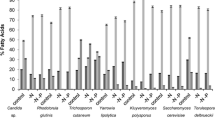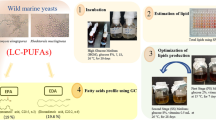Abstract
The mycelial dihomo-γ-linolenic acid content of an arachidonic acid-producing fungus,Mortierella alpina 1S-4, was found to increase, with an accompanying marked decrease in its arachidonic acid content, on cultivation with sesame oil. The resultant mycelia were found to be a rich source of dihomo-γ-linolenic acid. This unique phenomenon was suggested to be due to specific repression of the conversion of dihomo-γ-linolenic acid to arachidonic acid by the oil. After fractionation of the oil with acetone into oil and non-oil fractions, it was found that the effective factor(s) was present in the non-oil fraction. In a study on optimization of the culture conditions for the production of dihomo-γ-linolenic acid byM. alpina 1S-4, a medium containing glucose, yeast extract and the non-oil fraction was found to be suitable for the production. Under the optimal conditions in a 50-1 fermentor, the fungus produced 107 mg of dihomo-γ-linolenic acid/g dry mycelia (2.17 g/l of culture broth). This value accounted for 23.1% of the total fatty acids in the lipids extracted from the mycelia. The mycelia were also rich in arachidonic acid (53.5 mg/g dry mycelia, 11.2%). Other major fatty acids in the lipids were palmitic acid (24.1%), stearic acid (7.0), oleic acid (20.1), linoleic acid (6.6) and γ-linolenic acid (4.1).
Similar content being viewed by others
References
Stone, K.J., A.L. Willis, M. Hart, S.J. Kirtland, P.B.A. Kernoff and G.P. McNicol,Lipids 14:174 (1979).
Horrobin, D.F., and Y.-S. Huang,Int. J. Cardiol. 17:241 (1987).
Shimizu, S., Y. Shinmen, H. Kawashima, K. Akimoto and H. Yamada,Biochem. Biophys. Res. Commun. 150:335 (1988).
Fu-Lin, E., and J.L. Dupuy,Lipids 15:356 (1980).
Hulanicka, D., J. Erwin and K. Bloch,J. Biol. Chem. 239:2778 (1964).
Mead, J.F., inProgress in the Chemistry of Fats and Other Lipids, Vol. IX, edited by R.T. Holman, Pergamon Press, Oxford, 1971, pp. 161–192.
Yamada, H., S. Shimizu and Y. Shinmen,Agric. Biol. Chem. 51:785 (1987).
Yamada, H., S. Shimizu, Y. Shinmen, H. Kawashima and K. Akimoto,J. Am. Oil Chem. Soc. 64:1254 (1987).
Yamada, H., S. Shimizu, Y. Shinmen, H. Kawashima and K. Akimoto,Proceedings of the World Conference on Biotechnology for the Fats and Oils Industry, American Oil Chemists’ Society, Champaign, IL, 1988 pp. 173–177.
Shimizu, S., H. Kawashima, Y. Shinmen, K. Akimoto and H. Yamada,J. Am. Oil Chem. Soc. 65:1455 (1988).
Simizu, S., H. Kawashima, K. Akimoto, Y. Shinmen and H. Yamada,J. Am. Oil Chem. Soc. in press.
Werner, W., H.-G. Rey and H. Wielinger,Z. anal. Chem. 252:224 (1970).
Author information
Authors and Affiliations
Additional information
On leave from Suntory Ltd.
About this article
Cite this article
Shimizu, S., Akimoto, K., Kawashima, H. et al. Production of dihomo-γ-linolenic acid byMortierella alpina 1S-4. J Am Oil Chem Soc 66, 237–241 (1989). https://doi.org/10.1007/BF02546067
Received:
Accepted:
Issue Date:
DOI: https://doi.org/10.1007/BF02546067




